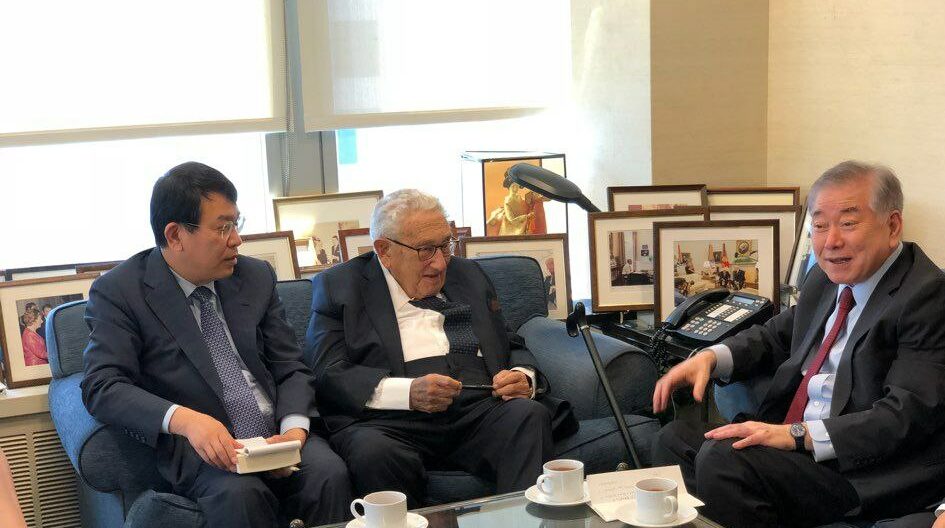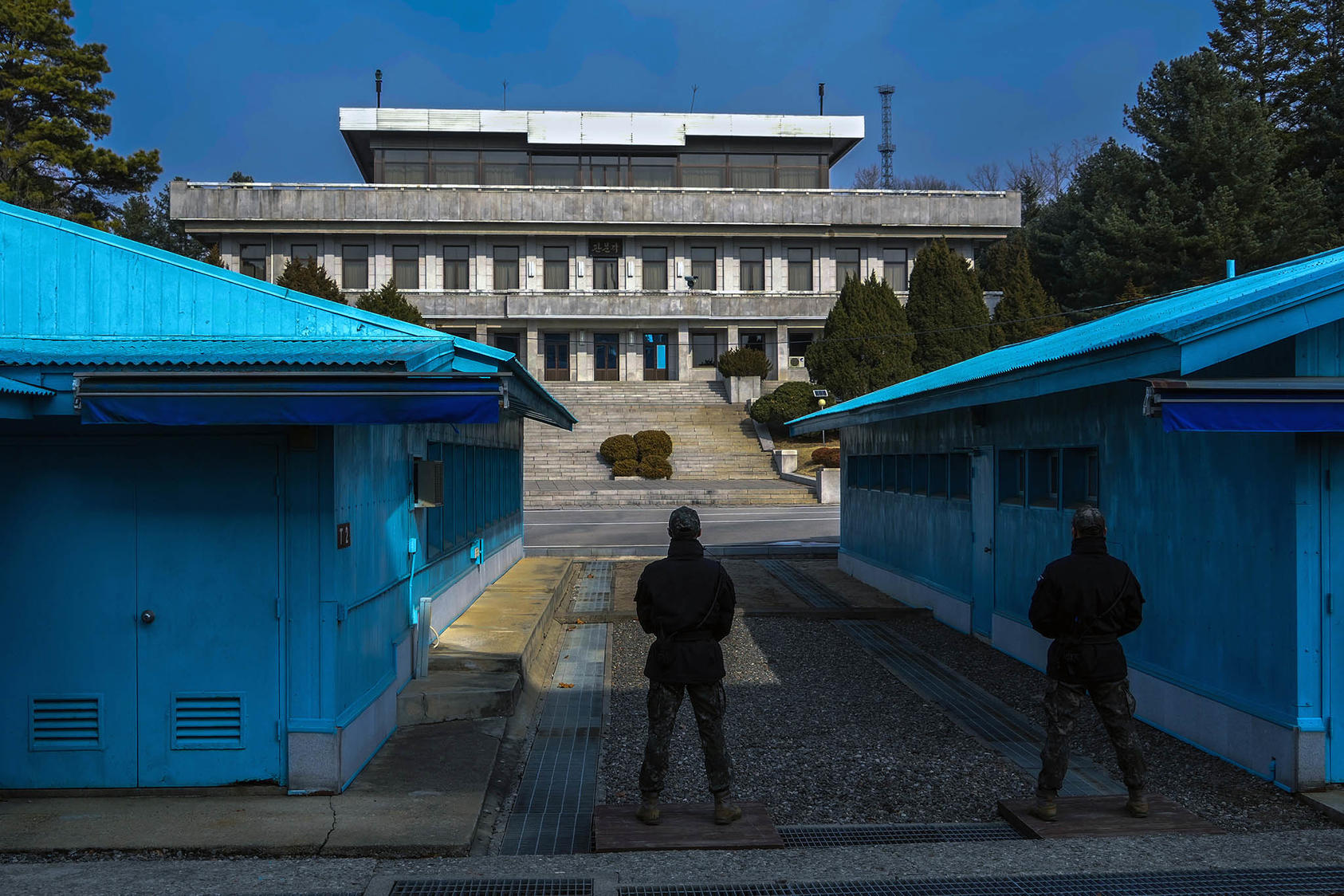For There to Be No Third War, We Need to Mitigate Crisis on Korean Peninsula
HANKYOREH
APLN member Cheong Wook-Sik, Director of the Hankyoreh Peace Institute and Director of the Peace Network, called for a creative resurrection of the six-party talks framework, in order to reduce tensions and break through the crisis on the Korean Peninsula. The original article can be accessed on the Hankyoreh website here.
Russia’s war in Ukraine and the ongoing war between Israel and Hamas have captured the world’s attention. We’ve seen the resurgence of discourse about the “two-war doctrine” as a result. In January, the UN reported that global conflict is at its highest level since the conclusion of World War II. This report is confirmed by joint research conducted by Sweden’s Uppsala University and Norway’s Oslo Peace Research Institute, which states that 55 armed clashes occurred around the world in 2022. The research also claims that the average length of armed conflicts has increased by around one-third to 8-11 years since 2020.
So what does this all mean? Once a war or armed conflict starts, it’s becoming harder to negotiate a truce or armistice. The mediating efforts and capabilities of the major powers such as the UN or US have also markedly diminished. Indeed, those powers’ direct and indirect involvement in the conflict is only making the situation more complicated.
A large part of that has to do with the busy strategic competition activities of the permanent members of the UN Security Council, who are assigned various privileges in the interest of “international peace and stability.” More than anything, the current state of our global village is one where the kind of diplomacy that prevents war by mediating and resolving conflict is more or less nonexistent.
We don’t need to look very far to find an example proving the lesson that wars are harder to end than they are to start. Our own Korean Peninsula has been in an armistice situation for over 70 years, with no formal end to the conflict or peace agreement.
These days, we are witnessing a situation where we once again have to fear the possibility of war on this peninsula. The signs of crisis, which had been mounting ever since the Korean Peninsula peace process ran aground in 2019, have been ramping up further with South and North Korea going through procedures for invalidating the Sept. 19 comprehensive military agreement they reached in 2018.
This amounts to the removal of one of the guardrails in place to prevent unintended clashes and escalation. Yet despite this development, we see no signs of any diplomatic efforts to quell the crisis.
Since being cut off in December 2018, inter-Korean dialogue has been in its longest idle since 1971. The same is true for North Korea-US dialogue, which has been suspended since October 2019.
Pyongyang is keeping the door to dialogue shut tight, and while Seoul and Washington claim the door to dialogue is open, they aren’t making any practical efforts to bring it about.
So are there no alternatives available for breaking through the crisis in Korea?
I see the situation as calling for a creative resurrection of the six-party talks framework, which continued from 2003 to 2008 with South and North Korea participating alongside the US, China, Japan and Russia. There are a few reasons for this.
The first has to do with its usefulness in terms of crisis management. People may differ in their assessments of the talks between the six parties, but it is evident that the multilateral meetings did contribute to managing and preventing threats on the Korean Peninsula during the first part of the ’00s.
At that time, the George W. Bush administration in Washington had named North Korea alongside Iraq and Iran as part of an “axis of evil” subject to preemptive strikes. The Agreed Framework reached in Geneva between North Korea and the US had been abandoned, and the North had launched its nuclear weapon development program in earnest.
Meanwhile, the US was adamantly refusing to engage in bilateral dialogue with Pyongyang. The Six-Party Talks made a big contribution to fixing this situation.
Inter-Korean and North Korea-US relations are also deteriorating rapidly these days, but the possibility of bilateral dialogue is very low. If we consider past examples, and the way that dialogue has contributed to preventing and managing crises, we can see here where the usefulness of the six-party dialogue lies.
The second reason is that this framework turns Korean Peninsula issues into six-party issues.
Recently, North Korea’s relations with China and Russia have been in their best condition since the early 1990s, in spite of Pyongyang’s declaration that it is “irreversibly” a nuclear state and the advancements in its nuclear capabilities. Between North Korea and Moscow, we’re even seeing signs of a military agreement.
Meanwhile, America’s alliances with South Korea and Japan have become increasingly stronger, while the trilateral relationship among them is close enough to evoke parallels with a trilateral military alliance.
This has prompted growing concerns that Korean Peninsula issues are shaping into a confrontation between South Korea, the US, and Japan on one side versus North Korea, China, and Russia on the other. It also conversely underscores the need for those six parties to come together and work jointly toward reducing tensions on the peninsula.
The third reason is feasibility. As chair nation, China has adhered to the principle that the six-party talks should be resumed and a balanced approach represented by the “freeze for freeze” and “double track.”
Moreover, China is the only one of the six parties in a position to communicate with all the other members. We can see evidence of that in the recent summits it has held with the US and Japan, two countries with which it has been in intense competition and conflict of late.
Russia’s proposal hasn’t gotten that much attention, but it is worth examining. In a press conference that followed his summit with North Korean Foreign Minister Choe Son-hui on Oct. 19, Russian Foreign Minister Sergey Lavrov said that Moscow “advocate[s] the establishment of a regular negotiation process on security issues on the Korean Peninsula without any precondition.”
While he didn’t explicitly say the words “six-party talks,” what he did say showed that this was what he had in mind.
For their part, South Korea, the US and Japan have consistently raised the need for dialogue with the North. If we take all these factors into consideration, the most realistic option may be to attempt to relax tensions on the peninsula by resuming the six-party framework.
If six-party talks are held, it would be a better approach to start off with minimalism as opposed to maximalism.
Initially, the aims of these talks were to achieve the Korean Peninsula’s denuclearization and establish a peace regime, develop inter-Korean relations and normalize North Korea’s relations with the US and Japan, and establish a peace and security system in Northeast Asia.
These are not goals that can be accomplished in the short term. This is especially true when it comes to the denuclearization that South Korea, the US and Japan have been emphasizing, or the removal of hostile US policies in line with North Korea’s demands.
Under these circumstances, pushing maximalist goals would end up turning the six-party talks into a shouting match, with a strong potential for making the situation even worse.
Accordingly, the framework should have the aim of setting minimalist tasks to accomplish first. The key focuses should be on preventing unintended clashes and escalation on the Korean Peninsula and devising measures to restore military trust from its current state of collapse.
One first step could be to resurrect previous agreements. That includes restoring the Sept. 19 inter-Korean military agreement of 2018 and the inter-Korean hotline, halting all North Korean nuclear tests and launches using ballistic missile technology, and postponing large-scale South Korea-US military exercises.
Other matters that should be brought up for discussion include suspensions of North Korea-Russia military cooperation and US deployments of strategic assets on the Korean Peninsula, as well as trilateral military exercises by South Korea, the US and Japan. Another thing to discuss is the declaration of passive security guarantees among the six parties, including pledges not to use or threaten to use military force.
Also worth considering is the formation of a joint research group by the six parties. This group could approach matters that require a fundamental, intermediate to long-term approach, such as resolving the Korean Peninsula nuclear issue, transitioning from an armistice regime to a peace regime, creating a peace and security system in Northeast Asia, normalizing North Korea’s relations with the US and Japan, and controlling and reducing armament in Northeast Asia.
To be sure, the parties involved could find themselves sharply at odds. This is one reason that I suggested a joint research group as an initial meeting framework.
An even better scenario would be a gathering where civilian experts participate from within the international community, including the six parties. These civilian experts could present views that are frank, creative, and balanced.
Image: Representatives for the six-party talks on North Korea’s nuclear program pose for a photo on Sept. 19, 2005 in Beijing after successfully adopting a joint statement on the fourth round of the talks. From left to right are Christopher Hill, US assistant secretary of state for East Asian and Pacific affairs; Kenichiro Sasae, Japan’s deputy director-general of Asian and Oceanian affairs; Wu Dawei, China’s vice minister of foreign affairs; Song Min-soon, South Korea’s deputy minister of foreign affairs; Kim Kye-gwan, North Korea’s vice minister of foreign affairs; and Alexander Alexeyev, Russia’s deputy minister of foreign affairs. (Yonhap)




